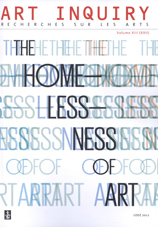Homelessness as the determiner of the artistic work of the Jewish diaspora in Central and Eastern Europe before 1939
Homelessness as the determiner of the artistic work of the Jewish diaspora in Central and Eastern Europe before 1939
Author(s): Irmina GadowskaSubject(s): Jewish studies
Published by: Łódzkie Towarzystwo Naukowe
Keywords: Jewish art; homelessness; diaspora; Bible; tradition
Summary/Abstract: In the Hebrew language, there exists the notion of “galut”, meaning exile, which expresses the physical and emotional condition of those deprived of their home country. It is associated with the feeling of alienation and unending wandering. A precondition of “galut” is the loss of a religious and ethnic centre – a “home”, which is connected with the longing for a mythologized past. In this context, homelessness, deriving from an inability to fulfil the desire to resettle the land promised by God, has become one of the crucial notions describing the condition of the Jewish people as well as an important factor moulding the character of the diasporal culture and art. Furthermore, homelessness may be treated as an immanent component shaping Jewish national identity. In its political and social dimension, the problem of homelessness lay at the heart of the Zionist movement and anti-assimilative movements. Leon Pinsker perceived the Jewish homelessness as one of the reasons for anti-Semitism, claiming that other nations consider themselves to be equal, since they possess a territory, which is necessary for existence, and a language. Unlike Pinsker, the supporters of Jewish culture development in diaspora saw homelessness as a value that contributed to the building of spiritual autonomy, leading unavoidably to differently manifested nationalism. The following text concerns the significance of the feeling of homelessness as one of the elements determining the character of Jewish art “in exile”. The awareness of that homelessness is variously reflected in works of art. Sometimes directly, as in the paintings whose subject is related to exile, wandering, escape. The protagonists in these representations are the people with the mark of otherness, wrestling with the lack of acceptance, like plants without roots, carried by the changeable wind of history from one place to another. Being homeless and unwanted, they shatter the ostensible homogeneity of the world around them. Dressed in traditional garments, leaning on sticks – the pilgrims’ attributes, they become the symbols of Jewish “ahasverism”. Another interesting aspect in my discussion on the homelessness of Jewish art is the issue of the importance and treatment of a (usually ritual) object. Mythical Bezalel was the first Jewish craftsman, who, according to God’s instructions conveyed by Moses, created and decorated a tabernacle and ritual vessels. These objects were easy to move, which was important in the then situation of the Jews, crossing from Egypt to the Promised Land. The Biblical story influenced modern art works. Before the 19th century, diasporal art was dominated by the creation of objects of cultic character. Those masterful items, easy to pack, of fixed symbolism, could easily find their place in the new surroundings, which, as long as it was not artificially created, like e.g. a museum space, assimilated them into the iconosphere of everyday life.
Journal: Art Inquiry
- Issue Year: 2011
- Issue No: 13
- Page Range: 95-118
- Page Count: 24
- Language: English

